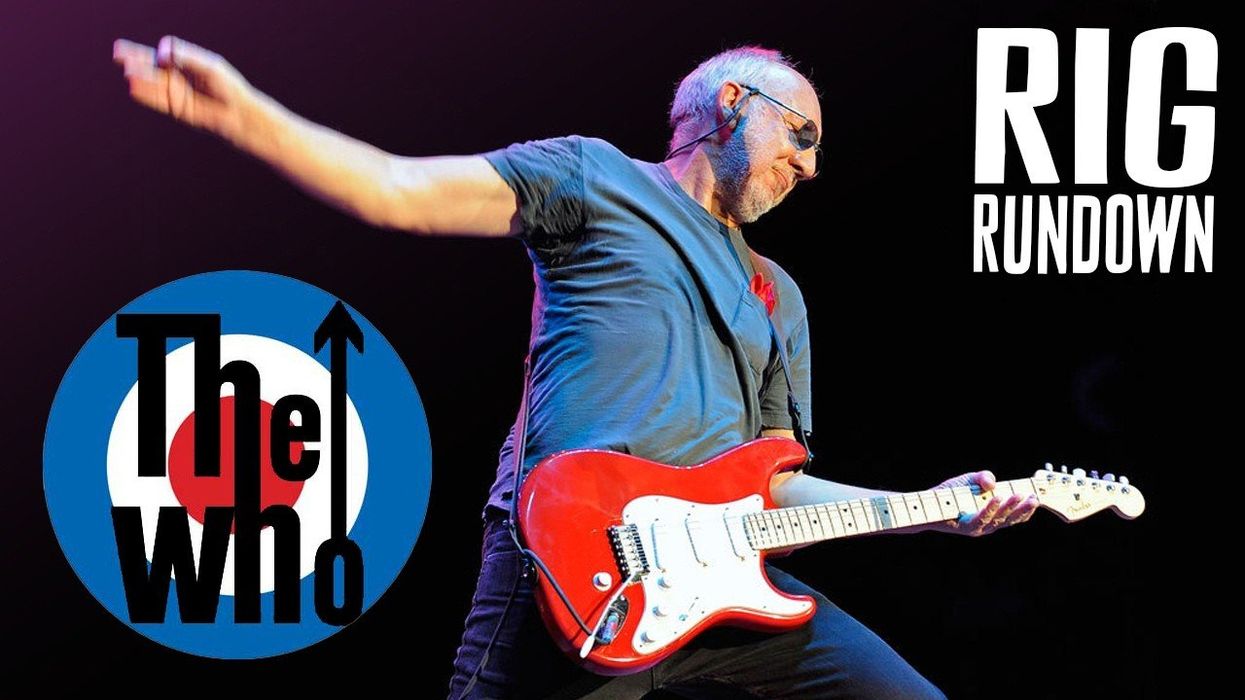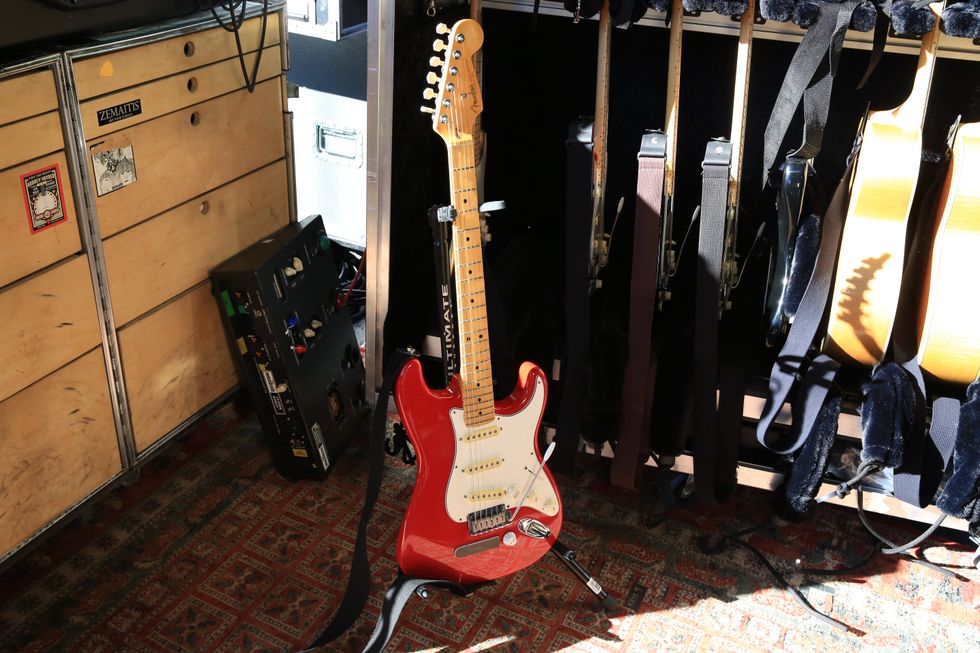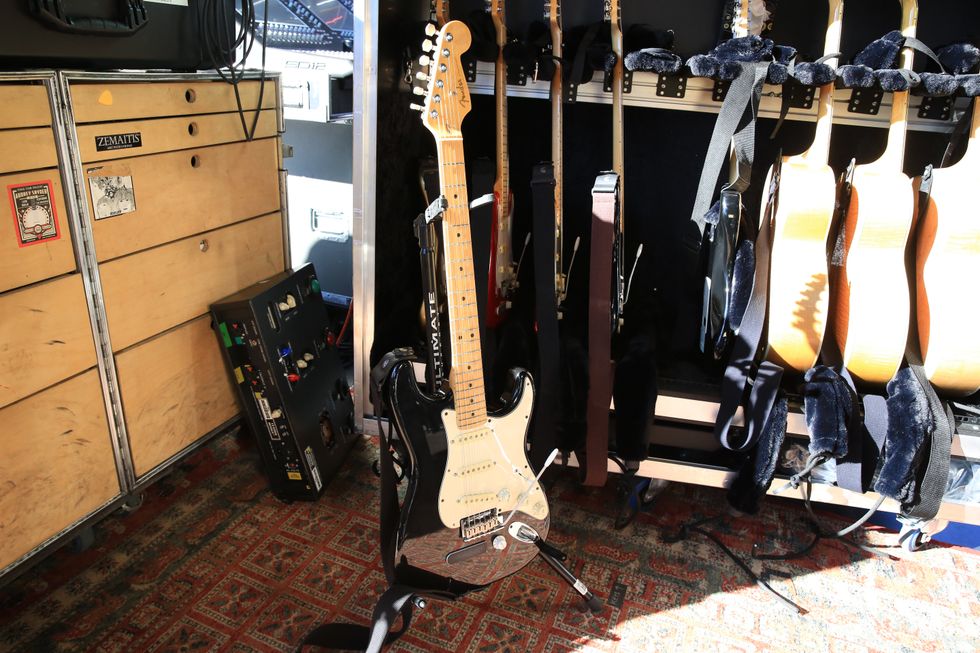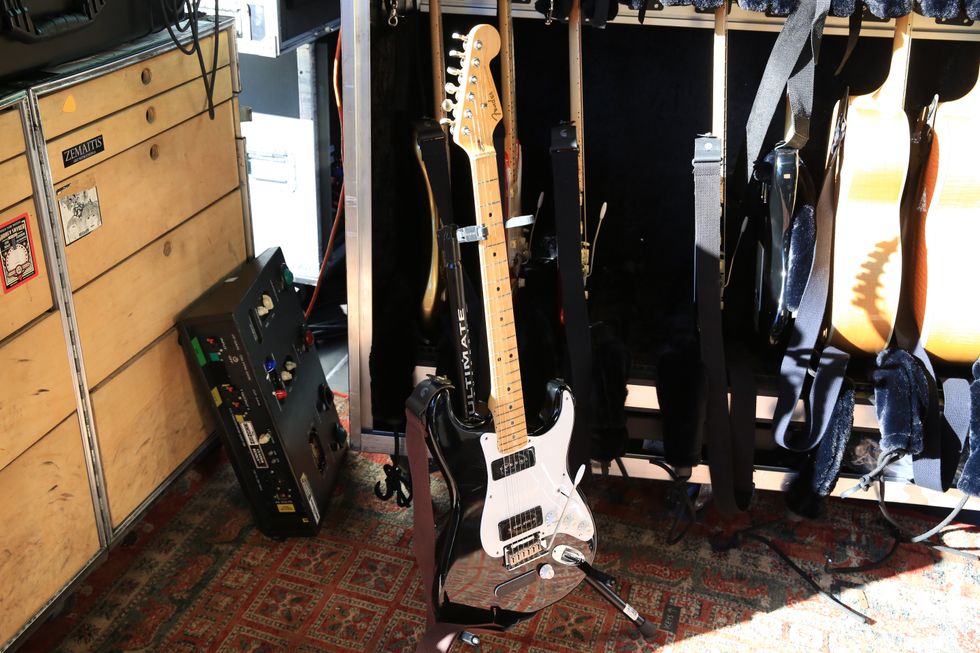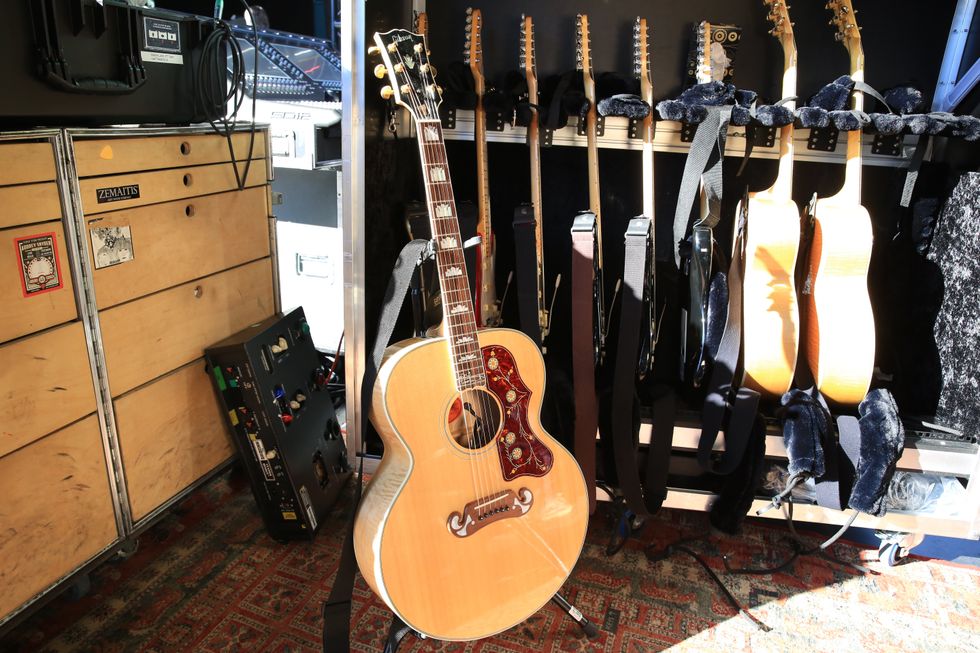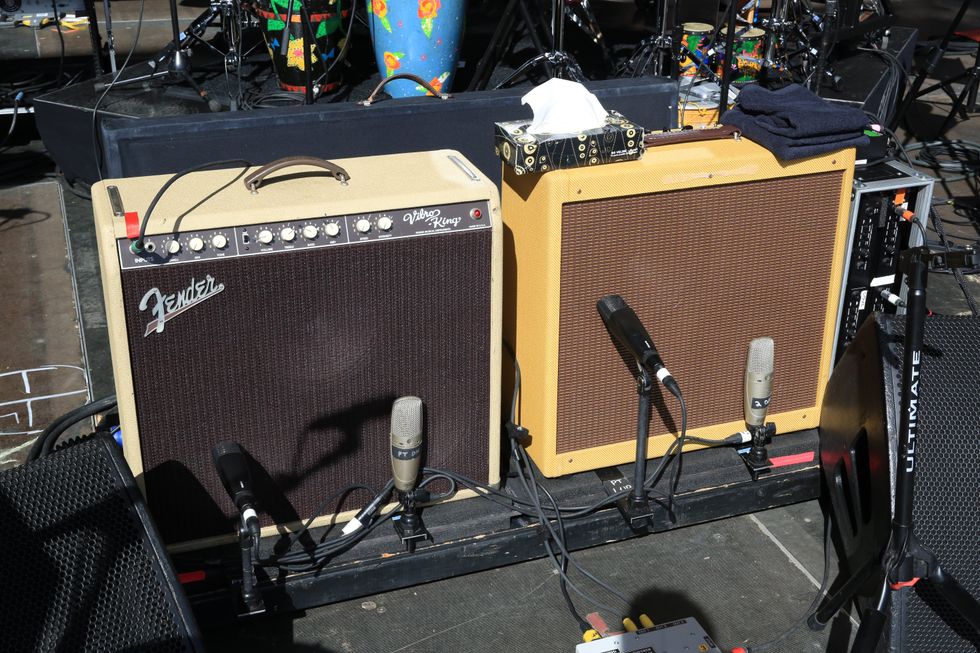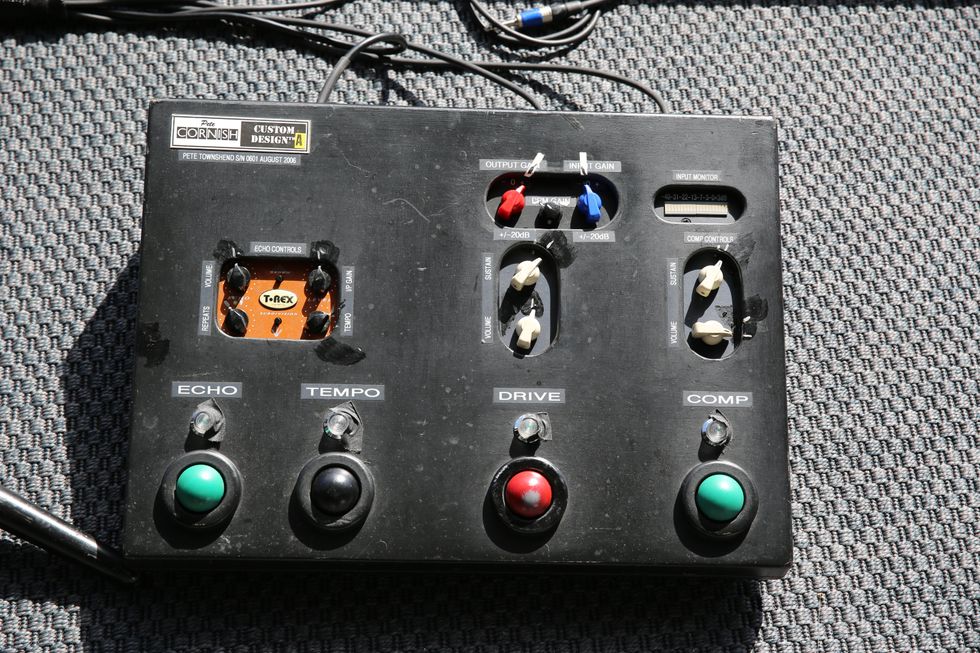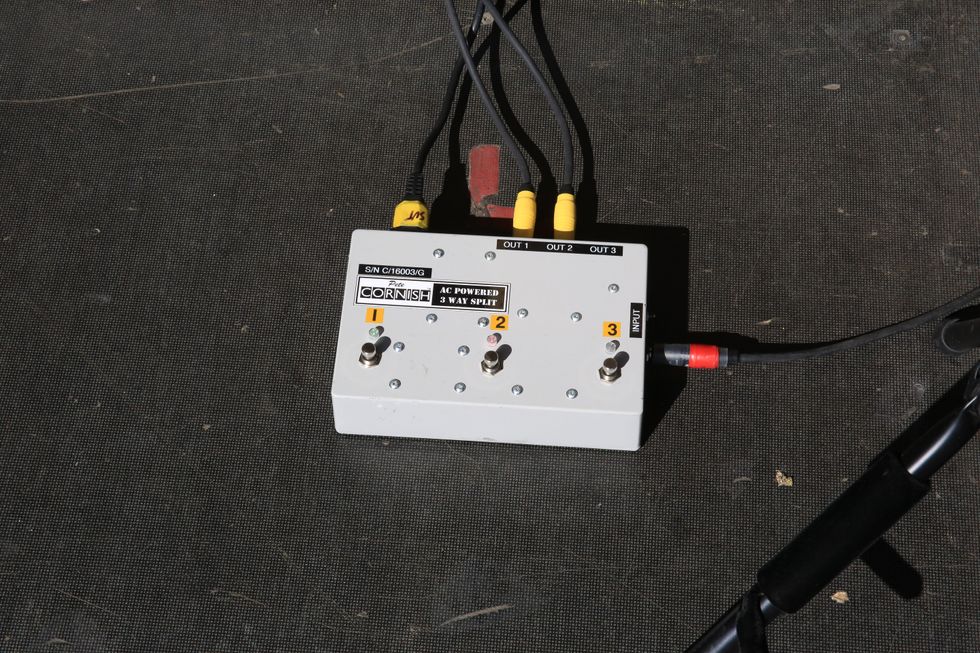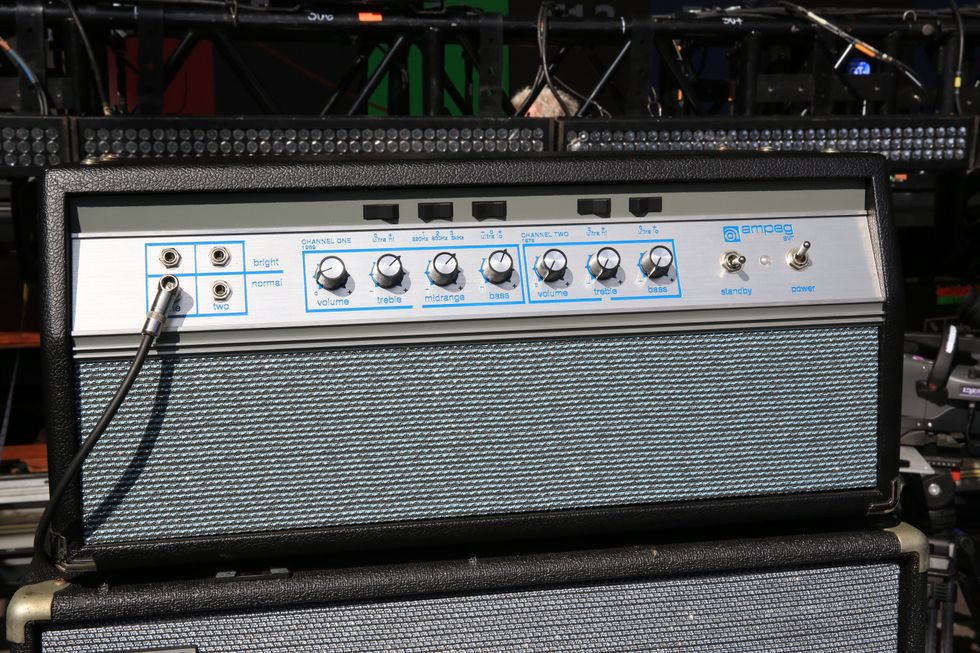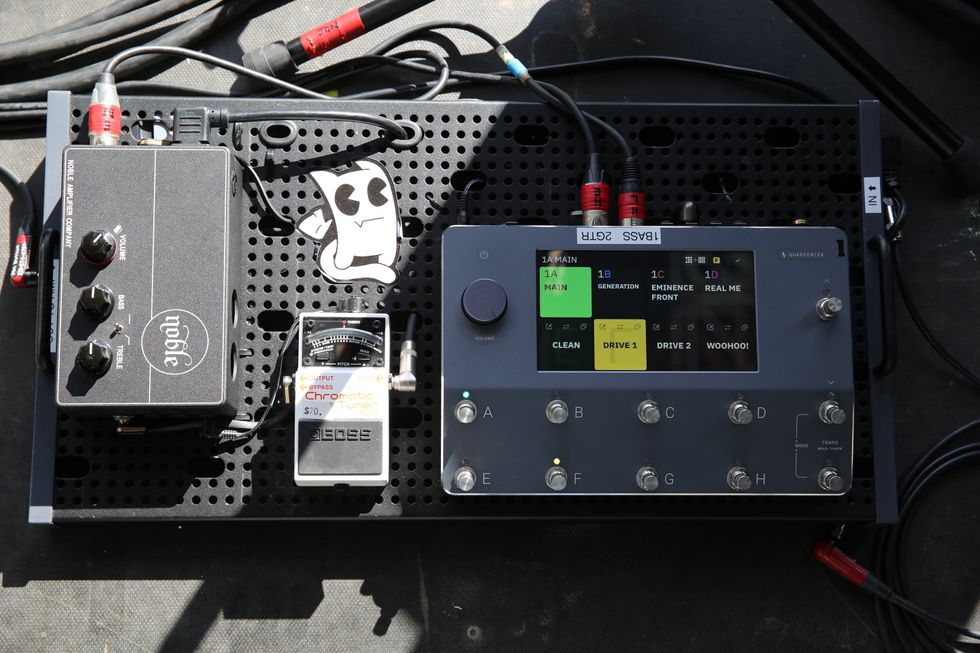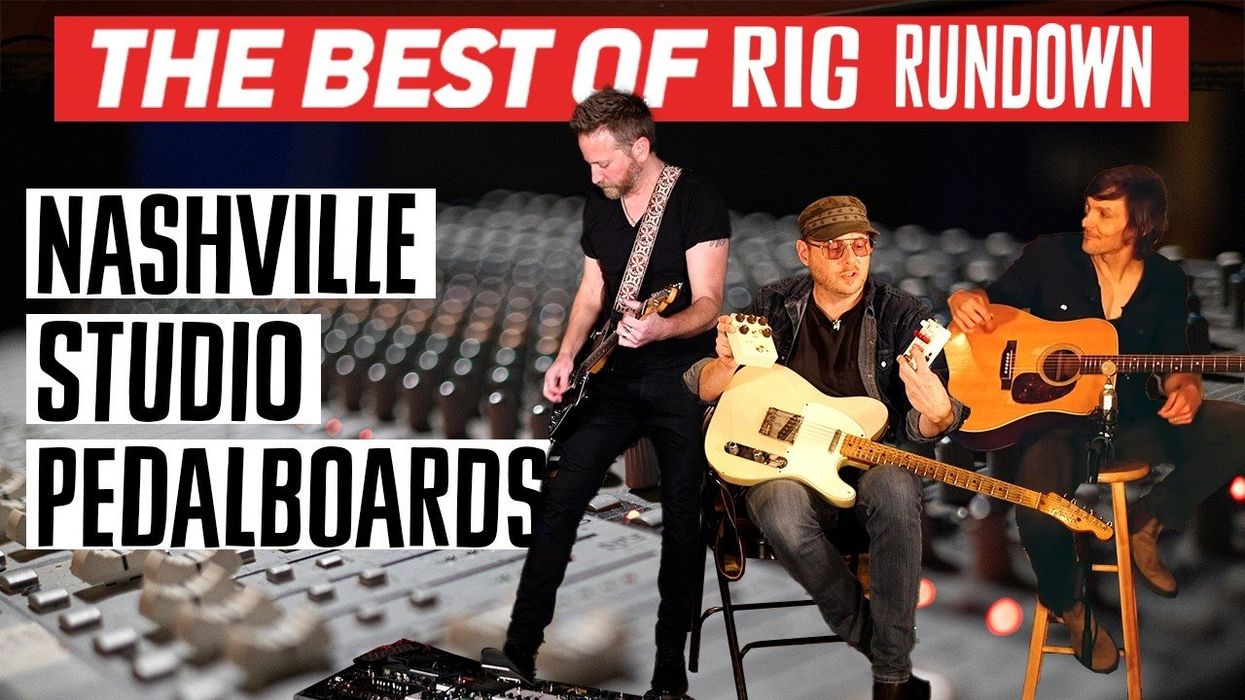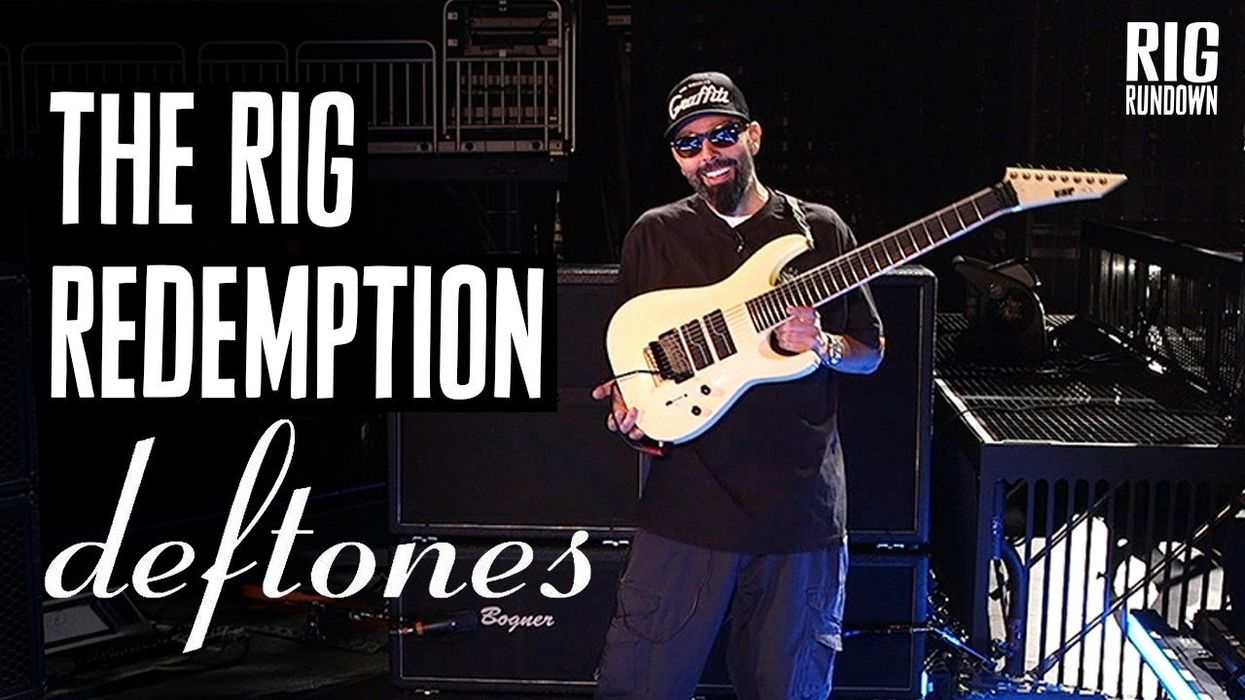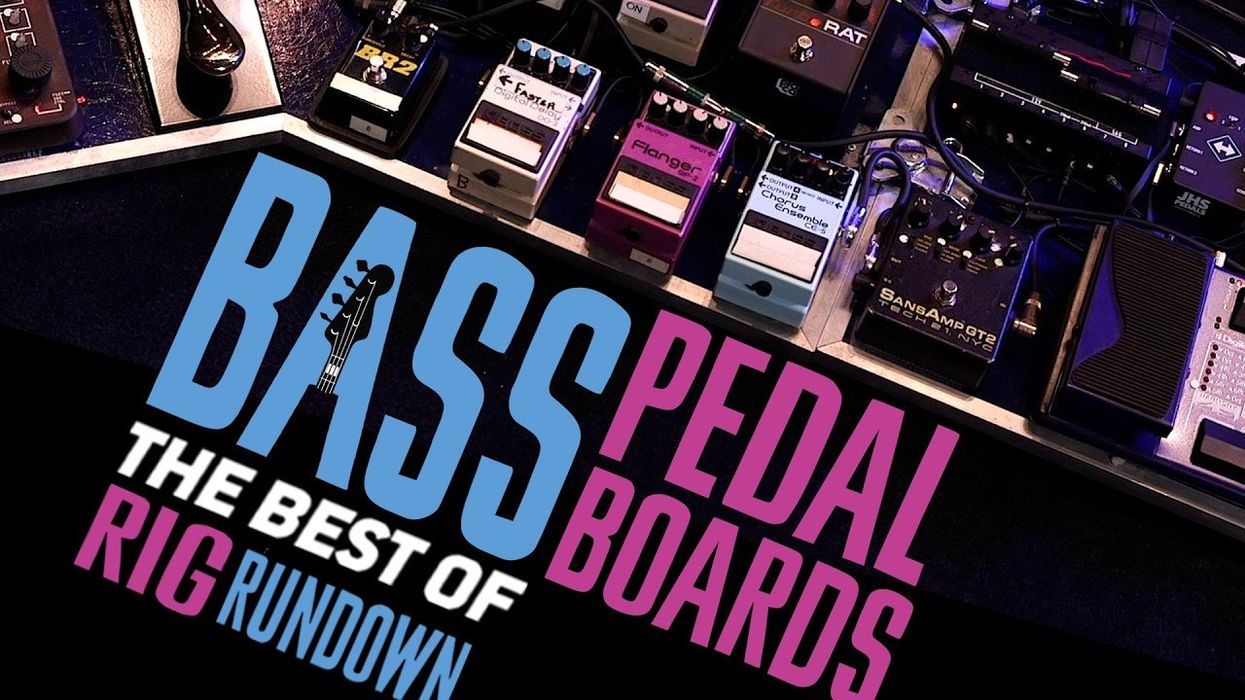Bartees Strange and his other guitarists engage in complementary “guitar wars” with their piles of pedals and stash of slinky Jazzmasters, Flying Vs, Teles, ES-335s, a space-age oddity, and a ’60s Silvertone with an onboard amp.
“You gotta remember, I wasn’t really shit until about a year-and-a-half ago,” Bartees Strange reminds the crowd at Nashville’s Basement East just before performing his song, “Hennessy.” “I was just in my basement playing guitar. And my wife was like, ‘Do the dishes ... Do something other than play guitar.’ Now all I do is play guitar again [laughs].”
Strange (born Bartees Leon Cox, Jr.), is a sponge and synthesis of everywhere he’s been and everything he’s seen or heard. Born in England and raised in Tulsa, Oklahoma, his experience performing with Brooklyn-based post-hardcore outfit Stay Inside and a later move to Washington D.C. have all contributed to his singular cosmic-slop sound. He notes during the Rundown that, as an adolescent, his guitar heroes were Thomas Erak of the Fall of Troy and Omar Rodríguez-López of At the Drive-In and the Mars Volta. But in the next sentence, he confesses his love for Nelly.
“I always thought people aren’t really honest all the time with what they’re listening to,” asserts Strange. “I think a lot of people like a lot of things. I grew up in a pretty country town, and everyone would say they just like country music. But I was like, ‘You like the Nelly record, dog. You like Get Rich or Die Tryin', man, and you also like LeAnn Rimes and Toby Keith songs, and Brad Paisley’s guitar playing. But you also jam B2K and pop songs, too.’ I’ve never been afraid or ashamed of what I like, so it all goes into my own music.”
What he’s been saying through 2020’s Live Forever and 2022’s Farm to Table has been connecting with fans and critics alike. The magnetism is Strange’s smooth synergy. This allows him to touchpoint influences from albums like Nelly’s Country Grammar, At the Drive-In’s Relationship of Command, the National’s Boxer, and Phoebe Bridger’s Punisher into one harmonious, original package that has landed him on dozens of year-end lists and earned him an 83/100 rating from Metacritic for both of his full-length releases. [Editor’s Note: The Metacritic website uses their proprietary Metascore to distill the opinions of the most respected critics’ writing online and in print to a single number.]
Finishing his earlier thought to the Nashville crowd, he summarized: “‘Hennessy’ is a song I wrote when I was a kid, and growing up I thought there was all these weird stereotypes I had to get over to become who I am … [The hook of the song is meant] to kind of say, I know there’s all these expectations of what a black person does … but I just want you to see me for who I am and for what I’m trying to say.”
He might not have been “shit” 18 months ago, but he’s certainly on his way to becoming the something of the sort in the coming years. We’ll be here listening and appreciating.
Ahead of Strange’s final 2022 tour date supporting Farm to Table, Bartees and his guitar-playing compatriots welcomed PG’s Chris Kies onstage at Nashville’s Basement East to talk shop. During the interview, the trio explained how their “guitar wars” create a compatibly melodic arms race and structure their cohesive sound. We get introduced to a collection of oddball axes and go through their collective setups—which Strange fondly refers to as “Tone Capital”—assisted by a store’s-worth inventory of pedals. Plus, stick around after the Rundown to check out a heartfelt message from Bartees and the band’s wonderful performance of “Hennessy.”
Brought to you by D’Addario XPND Pedalboard.
Bartees’ Battle Axe
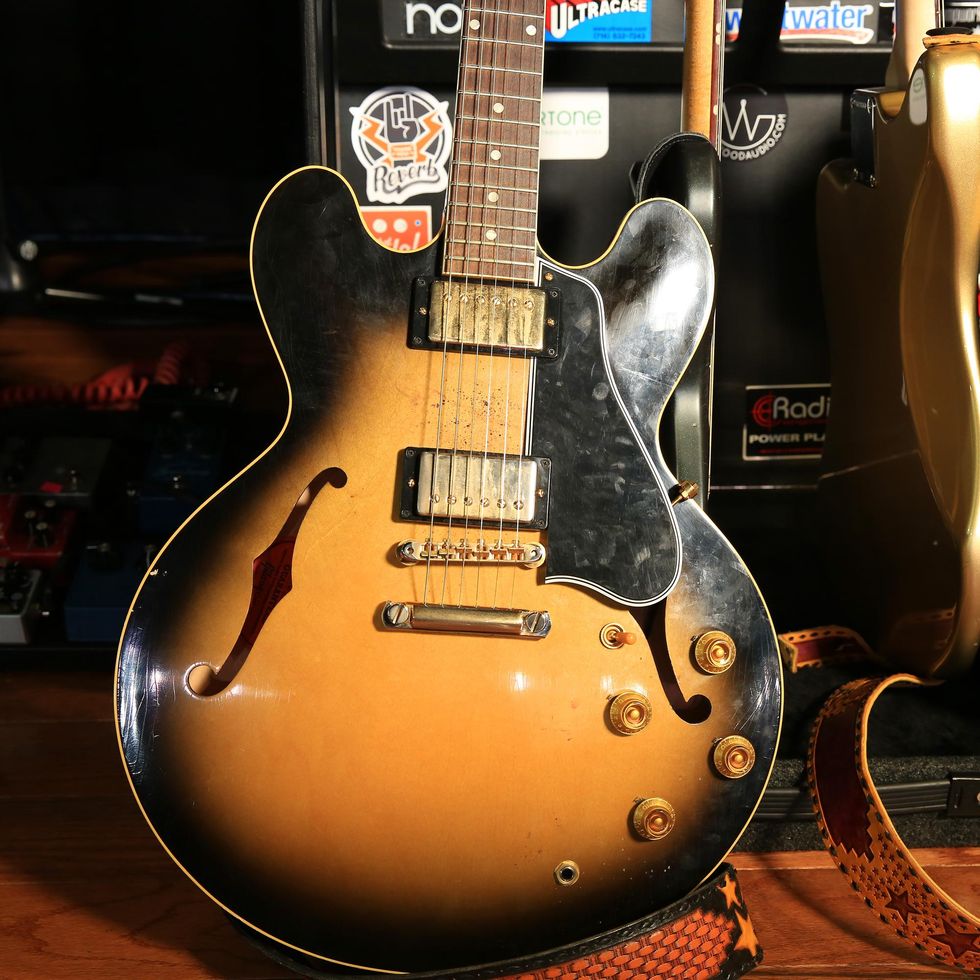
Strange’s main axe for much of 2022 was this 1959 Gibson Custom Shop ES-335 Reissue “Chicago Music Exchange Spec” that features the delicate deterioration of the Murphy Lab treatment. It has a maple body (with a maple center block and red-spruce bracing), a 1-piece mahogany neck, an Indian rosewood fretboard, Kluson tuners, and custom CME-spec “S” Gibson humbuckers.
“Honestly, it’s pretty sick. It’s the dopest 335 I’ve ever played,” contends Strange. “It has a very versatile sound, and with its low-output humbuckers I can get it to chirp a little bit, but I also can go off on it.”
It has replaced touring duties for his beloved 1967 Epiphone Casino and a 1963 Gibson ES-125T. This and the rest of his riders take D’Addario EPN115 Pure Nickels (.011–.048). The 335 will stay in either standard or D-A-D-A-A-E tunings.
Strange Baraniks

After Bartees’ 2020 debut, Live Forever, came out, luthier Mike Baranik built Strange this Baranik RE-1 that boasts a reflective pickguard with the words “Never Die” emblazed on it. Its standout specs include a Baranik handwound gold-foil-style pickup that slides, a groovy, give-it-a-rip Göldo DG Tremolo in Shorty-Design, an illuminated control pod, and wooden saddles. It comes in at a feathery 6 pounds. Strange busts it out for his song “Heavy Heart” because of the guitar’s jangly grind.
“The RE-1s were designed to simplify the manufacturing without losing the most critical parts of a guitar, playability and tone,” says Baranik. “Almost every single one of the RE-1’s parts are made here in the shop from repurposed materials.”
Goldilocks
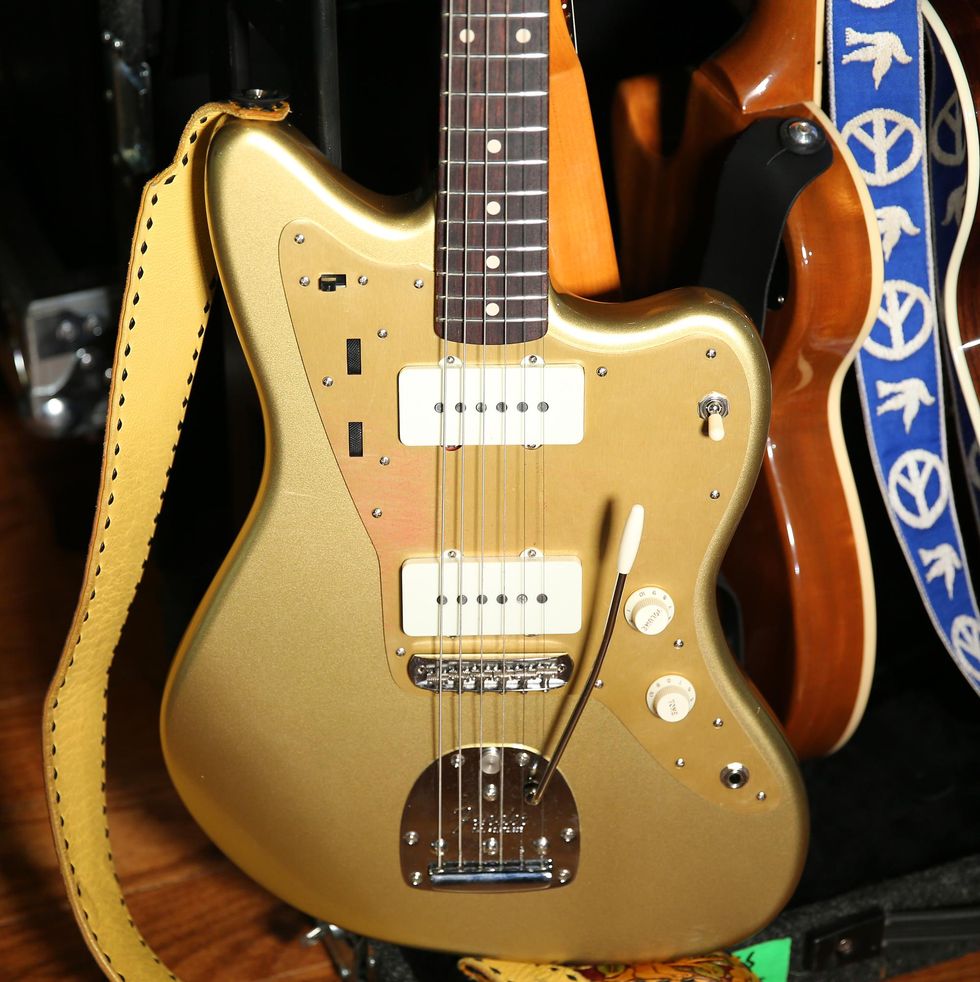
Another one of Strange’s treasures is a 1959 Fender Jazzmaster. That classic stays at home, but he needs the instrument’s sonic flair for his nightly set, so he contacted Fender’s Jason Klein and sent over a request to recreate his ’59 with a few slight cosmetic changes. He wanted an Aztec gold finish with a matching headstock, complete with an anodized pickguard. Strange often starts the set with this golden goose on songs “Escape the Circus” and “In a Cab.”
A Low-Price Highball
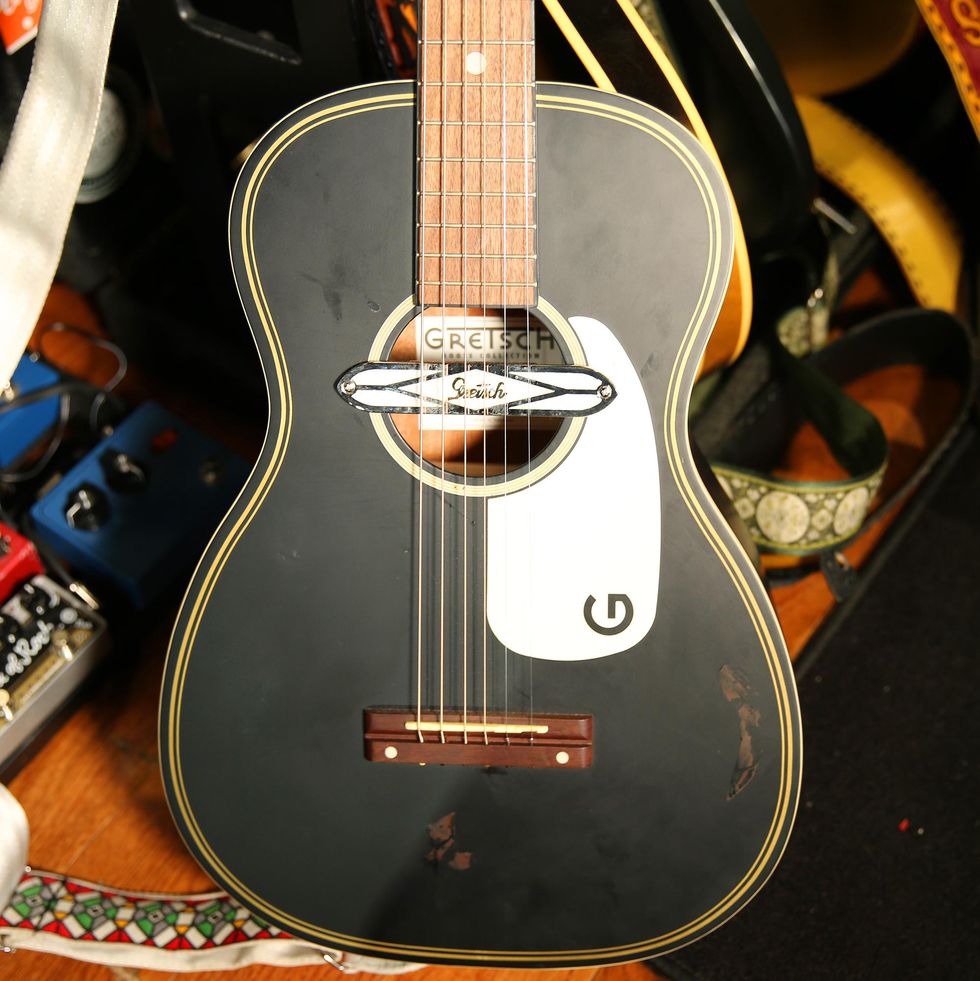
Like his other touring guitars, this Gretsch G9520E Gin Rickey acoustic/electric fills in for his pricier, vintage flattops. The price was right at under $300, and Strange really loves its darker, boxier sound that meshes well with Graham’s brighter Orangewood acoustic. Another plus was that it came stock with a Gretsch Deltoluxe soundhole pickup that enables Bartees to run this into his Vox AC30.
A Voxy Solution
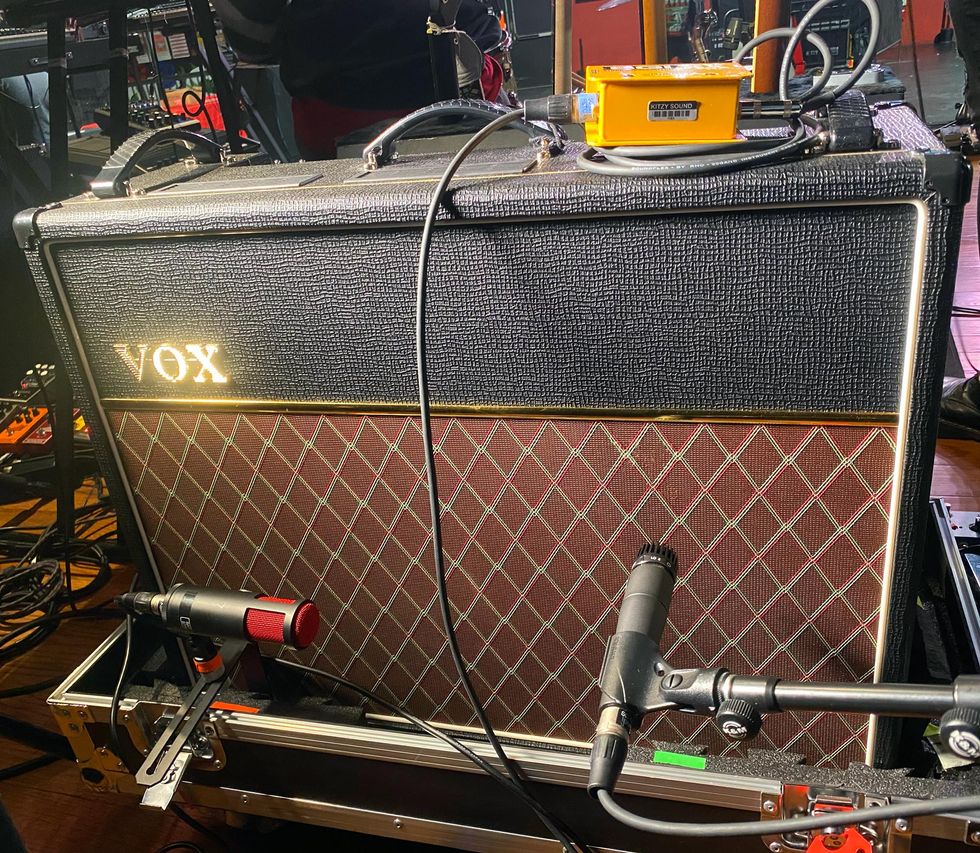
“In Tone Capital, U.S.A., things can change. The weather, all kinds of things … but honestly, the three of us are always kind of looking at each other like, ‘What is not right? Is it an amp? Is it a guitar?’ There’s dysfunction in Tone Capital, so after spending a lot of time with Fender amps, I’ve returned to AC30s for its crisp highs that match really well with the dark, mellower vibe of the 335,” says Strange. He plugs his guitars into the Vox AC30C2X’s low-input/top-boost section. This particular 30-watt combo comes with a pair of 8-ohm Celestion Alnico Blue speakers.
Bartees Strange’s Pedalboard
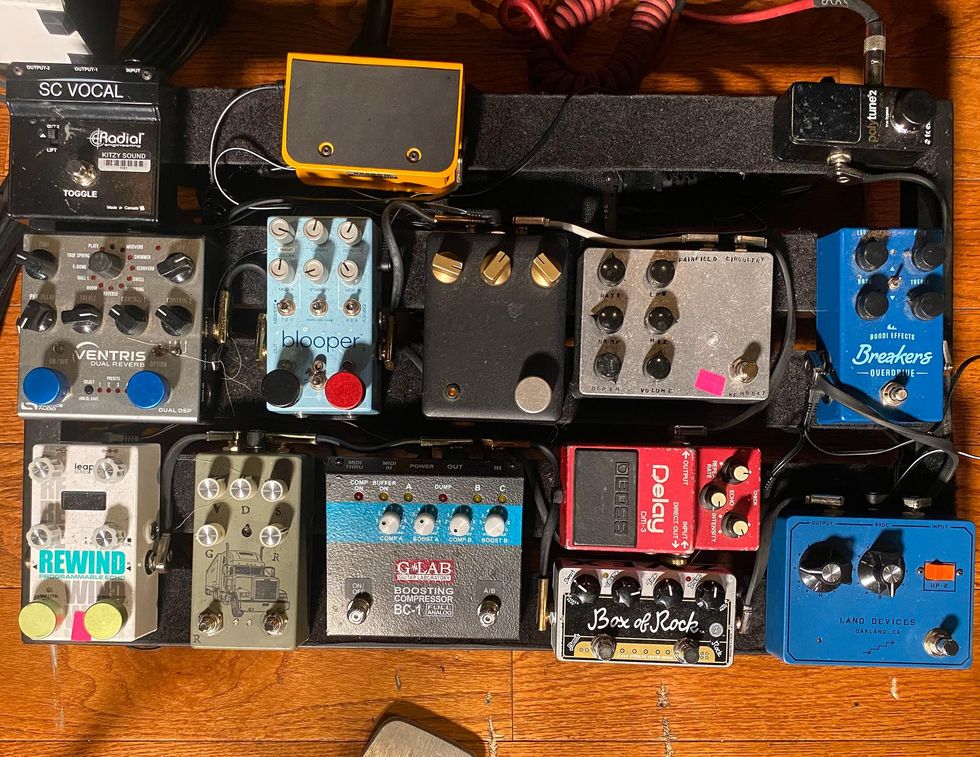
As the governor of Tone Capital, Strange has the most advisors on his board. Breaking them down by function, Bartees’ dirt and filth comes from a Land Devices HP-2, Fowl Sounds Obsidian Fuzzstortion (the unmarked black box), Bondi Effects Breakers Overdrive, and a ZVEX Box of Rock. Time-based effects include an Alexander Pedals Rewind Programmable Echo, a Boss DM-3 Delay, and a Source Audio Ventris. Bartees’ modulation machines are a Farm Pedals Tombstone Tremolo and a Fairfield Circuitry Shallow Water K-Field Modulator. Two other noise manipulators include a Chase Bliss Blooper and a G-Lab BC-1 Boosting Compressor. Other boxes are a Radial SGI guitar interface (upside-down at the top), a Radial HotShot DM-1, and a TC Electronic PolyTune 3 Noir Mini.
A V for G
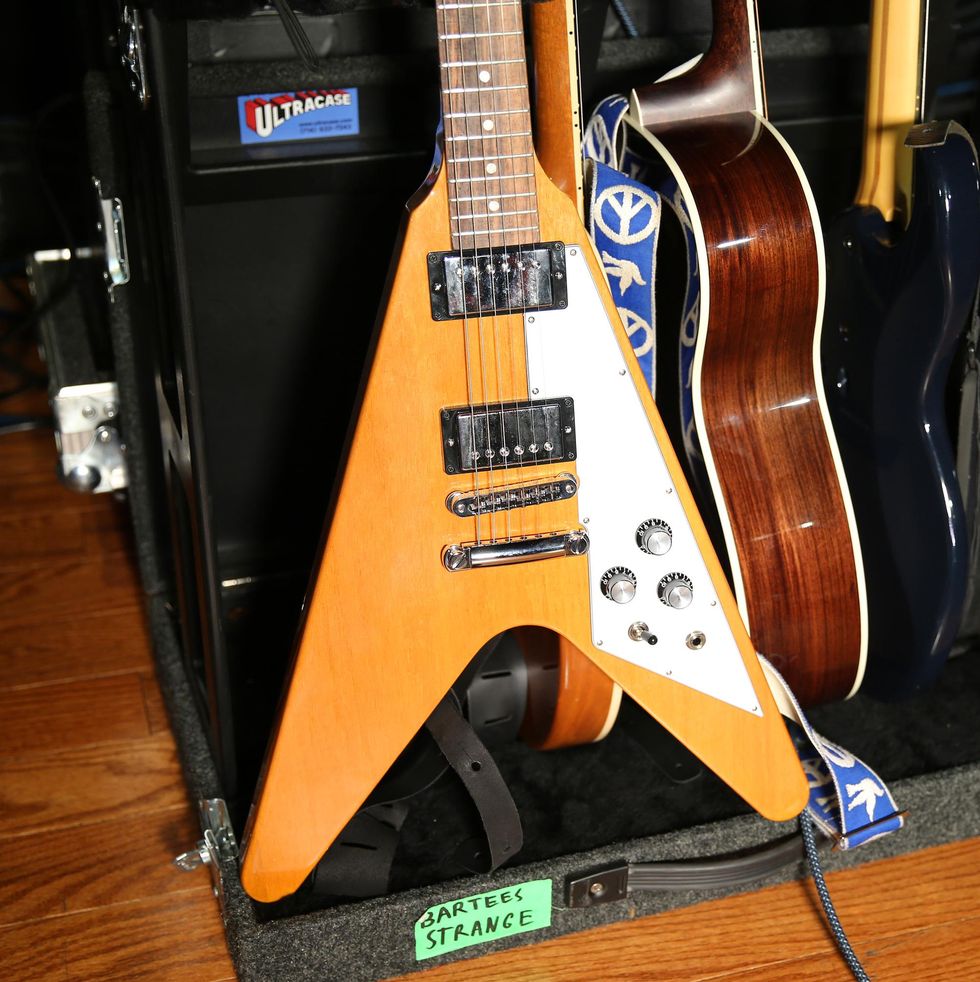
“I just got this for this tour. I kind of bought it because I thought it’d be the most ridiculous guitar that I could bring onstage, but I’ve slowly discovered it’s the most the comfortable instrument I’ve ever had,” admits multi-instrumentalist Graham Richman. The 2022 Gibson Flying V in antique natural has stayed the same since he bought it, except for the fresh set of D’Addario EPN110 Pure Nickel strings (.010–.045).
Les Paul, More Gristle
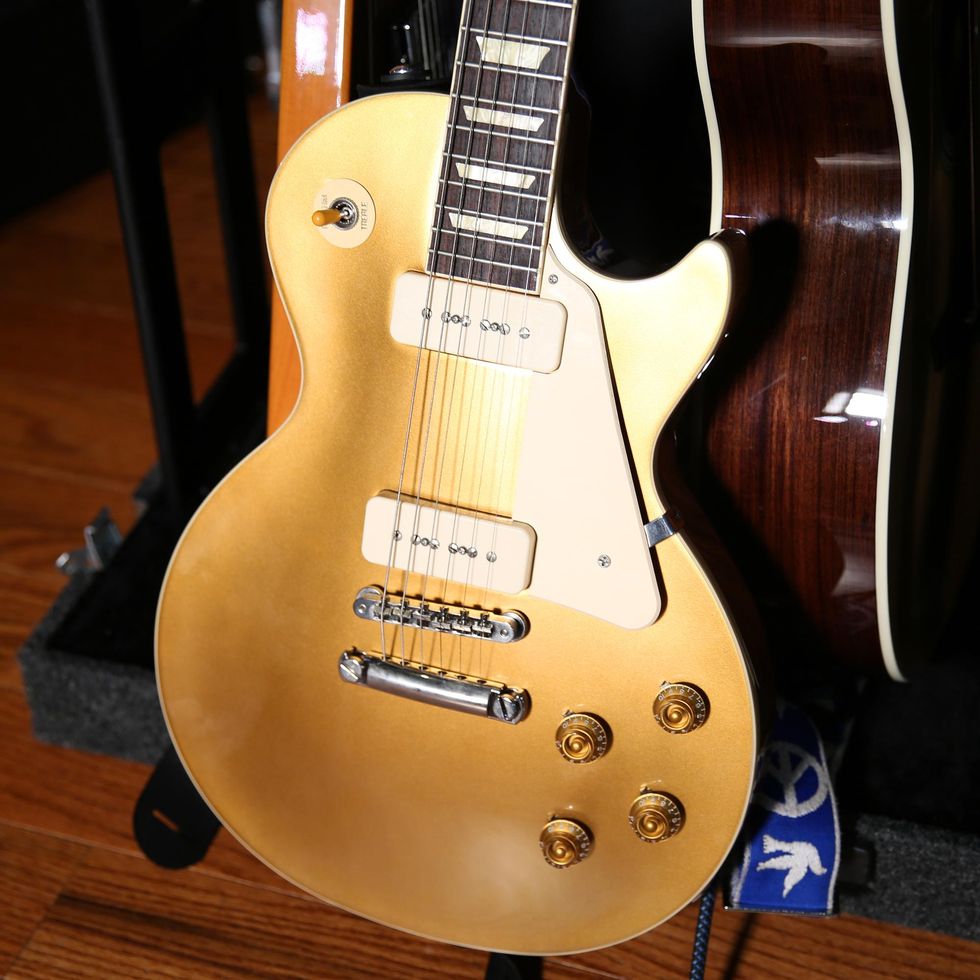
This one used to be Richman’s number one, but only gets action for one or two songs, like “Kelly Rowland.” He still enjoys playing the Gibson Les Paul Standard ’50s P-90 because it has “more gristle and cuts in an interesting way,” compared to his V.
Orange You Glad to Play Me
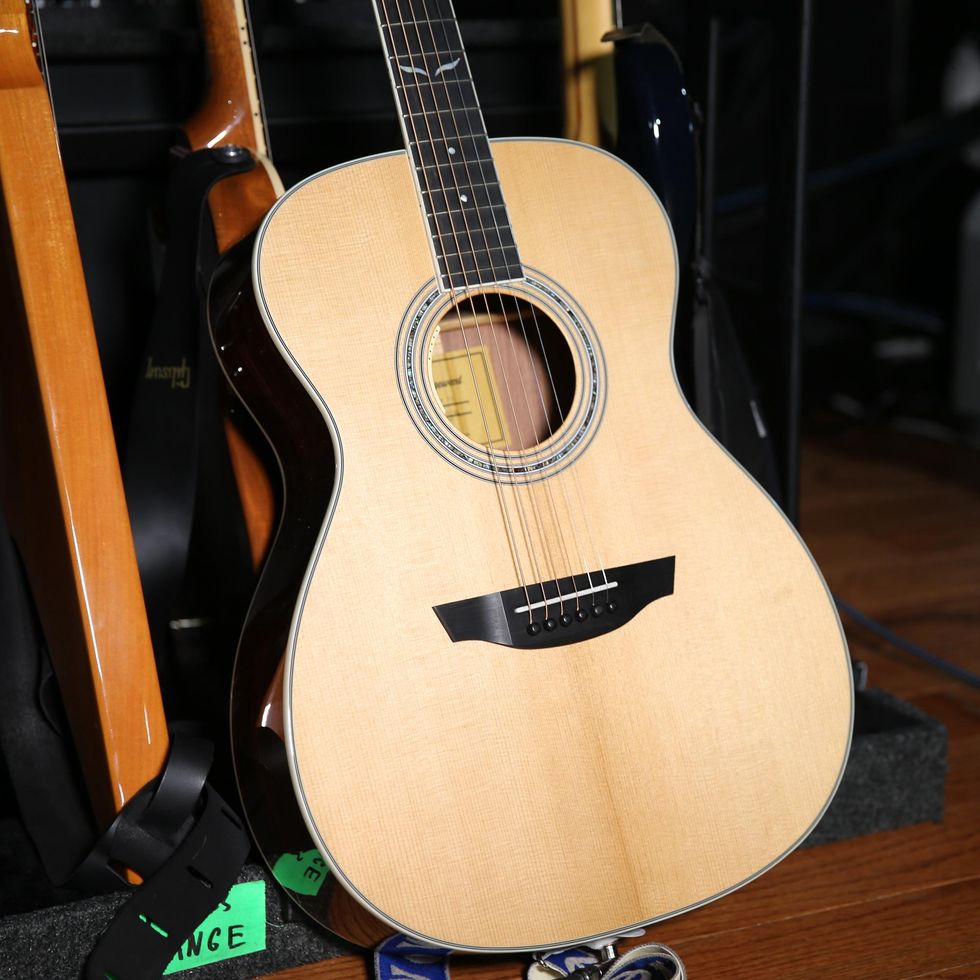
For “Black Gold,” Graham puts on this Orangewood Sierra Live, that’s equipped with a L.R. Baggs Anthem pickup.
Deluxe Bassman
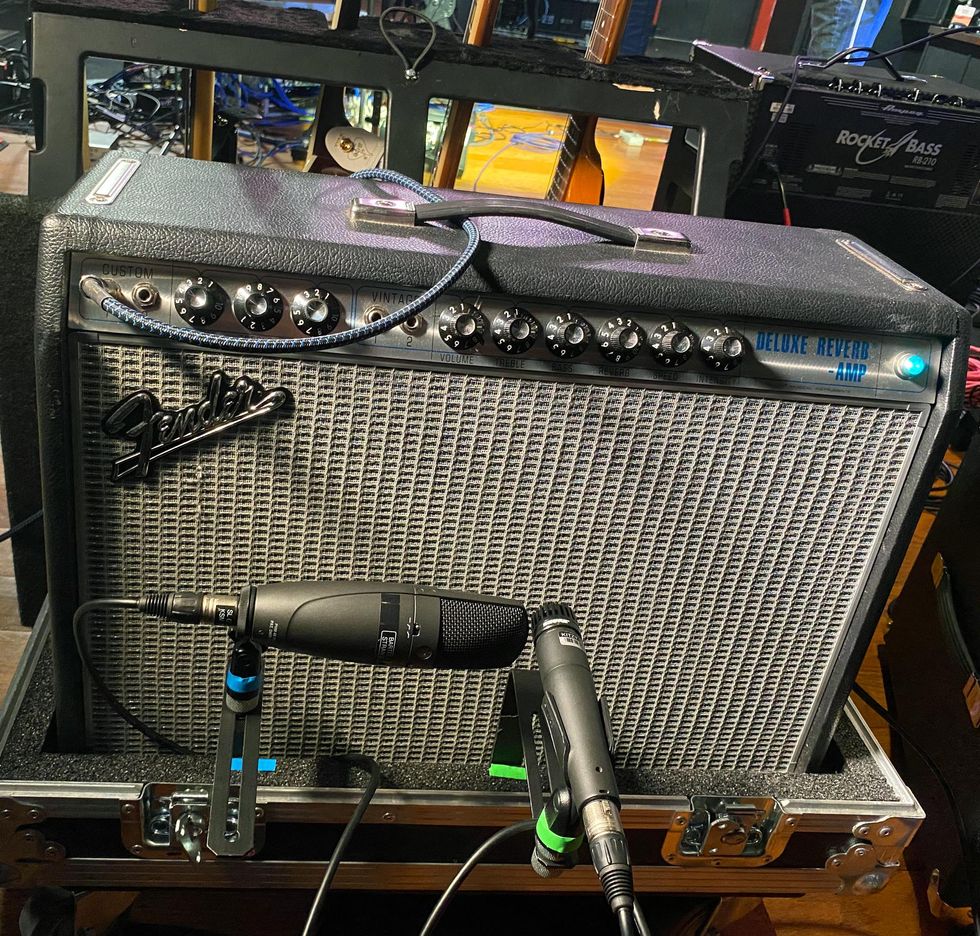
Richman runs all of his electrics into the above Fender ’68 Custom Deluxe Reverb. He landed on this combo because of the punchier Bassman circuit inside the Custom channel.
Graham Richman’s Pedalboard
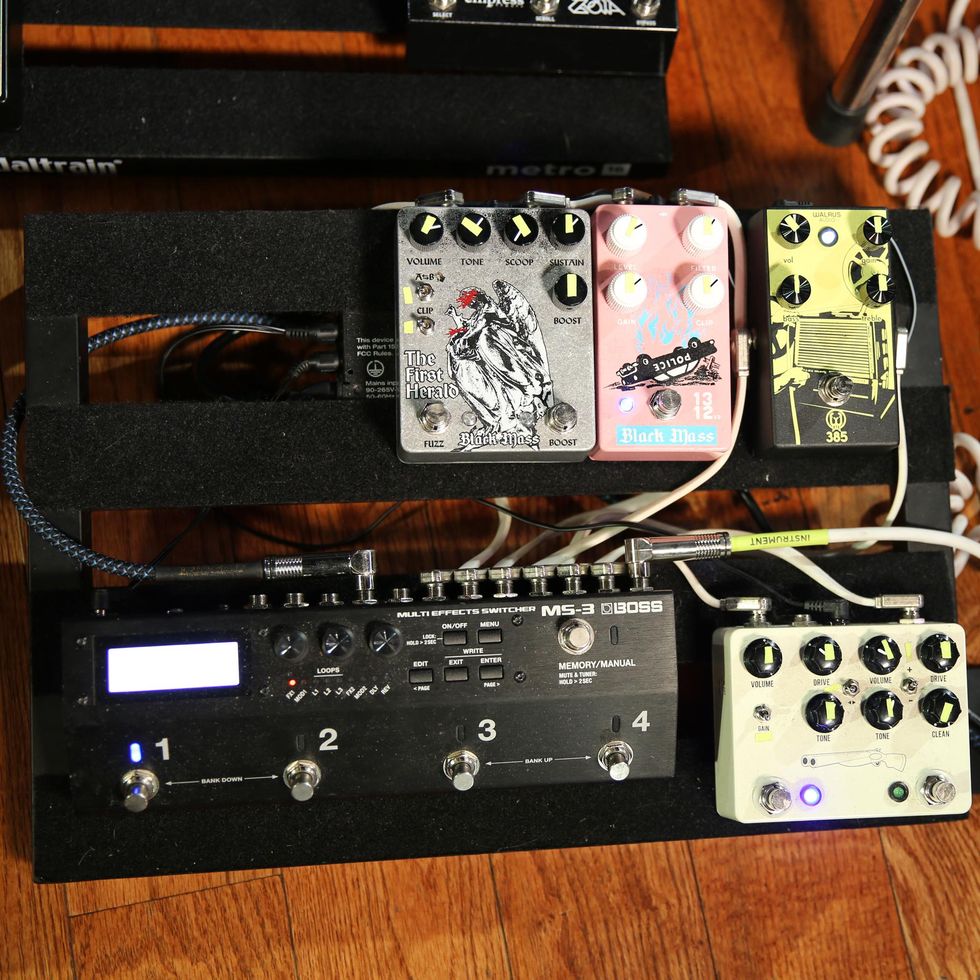
When you’re a touring musician, cartage costs for gear are always a concern, and it’s no different for Richman. He downsized his setup to a Pedaltrain Metro 16 thanks in big part to the Boss MS-3 Multi Effects Switcher that not only can control MIDI pedals on his board, but also offers 112 internal effects, too. Graham relies on the MS-3 for all his delays, reverbs, and modulation. His gain stages come from nearby standalone pedals: Black Mass Electronics The First Herald, Black Mass Electronics 1312 Distortion V3, Walrus Audio 385, and a JHS Double Barrel.
Surface-Level SG
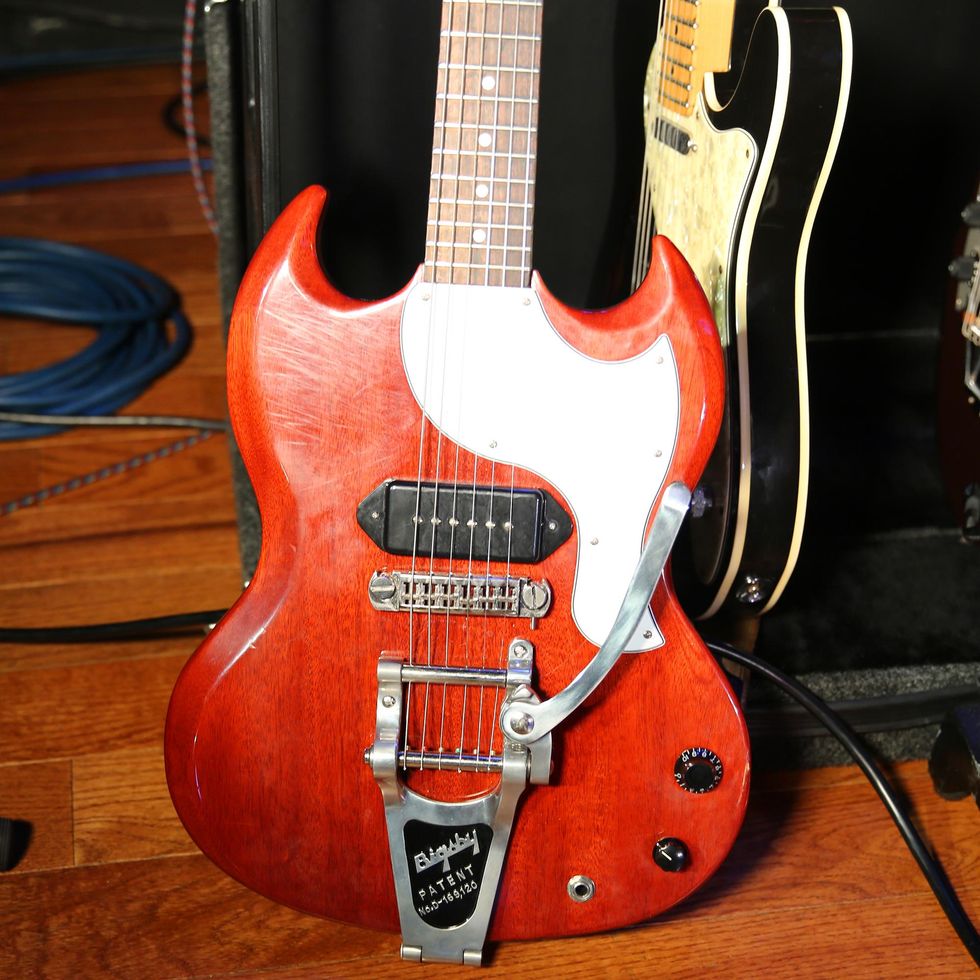
“Honestly, it was an aesthetic-first purchase,” concedes guitarist Dan Kleederman. “It’d be really cool to play a SG Junior in this band—I hoped I’d like it … and I did!” This sweet surprise is a 2021 Gibson SG Junior that appears to be all stock, but he added a Bigsby B7 vibrato and a push-pull switch on the tone that cuts higher frequencies when pulled out. He said he was sold on its sound once the band made the move to in-ear monitors, because it sits in its own lane within the three-guitar attack. And because of that, this one sees the most action of Kleederman’s trio.
Hand-Me-Down Tele
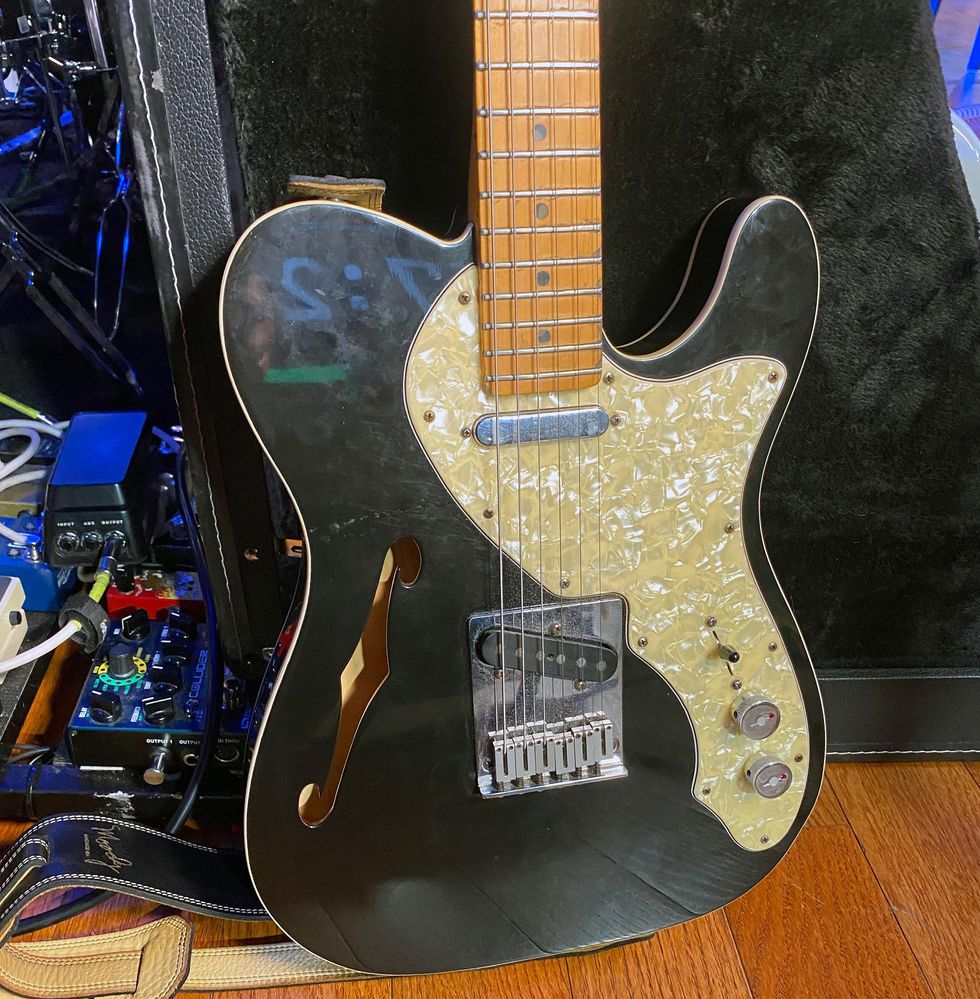
This 1998 Fender USA Thinline Telecaster is from Dan’s father, who bought the Tele in the early 2000s and recently loaned it to him. He gave Dan his blessing to customize it as he saw fit—so it now has a 4-way selector unlocking a series circuit that combines the bridge and neck pickup for a beefier, hotter signal. You’ll also notice that tone and volume control knobs are pulled from a Gretsch. “I’m in a phase where I like messing with the guitars and their looks,” says Dan. He uses this guitar every night for “Heavy Heart.”
Speaker of the House
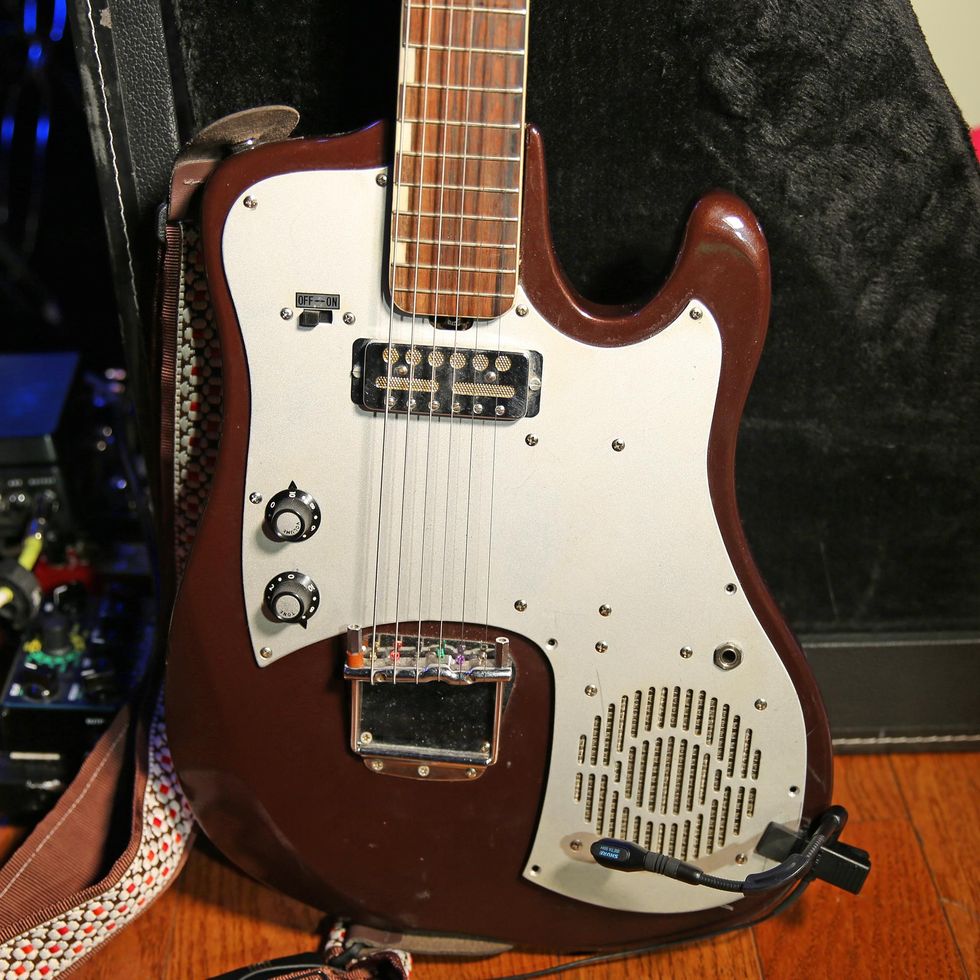
“This is a very special situation here. Part of what makes this guitar unique is the fact that it has a built-in amplifier that you can turn on and off,” details Kleederman. The 1960s Silvertone 1487 TG-1’s gold-foil pickup is original, and was the initial allure for Kleederman to make the purchase.
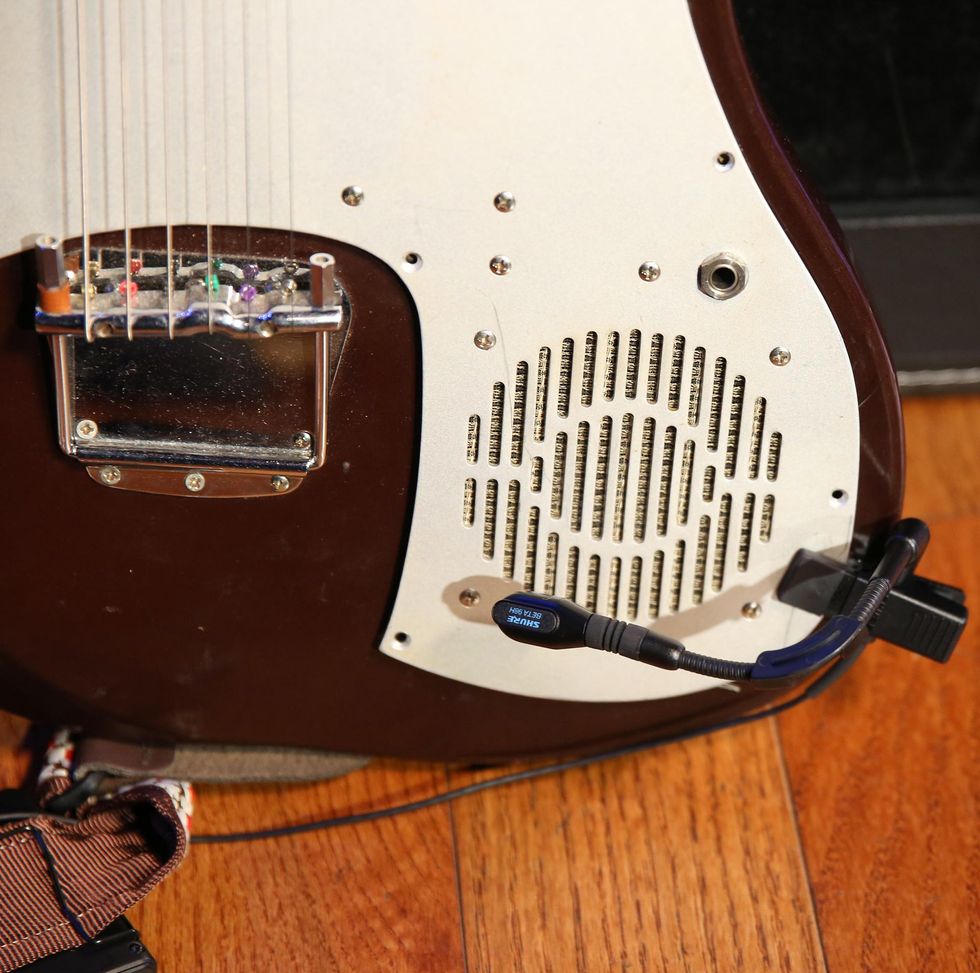
And for “Hold the Line,” where Dan plays slide—to give the song a rustic, back-porch, AM-radio vibe—he engages the tiny amplifier and sends a signal to FOH via a Shure Beta 98H/C.
Foxy Voxy
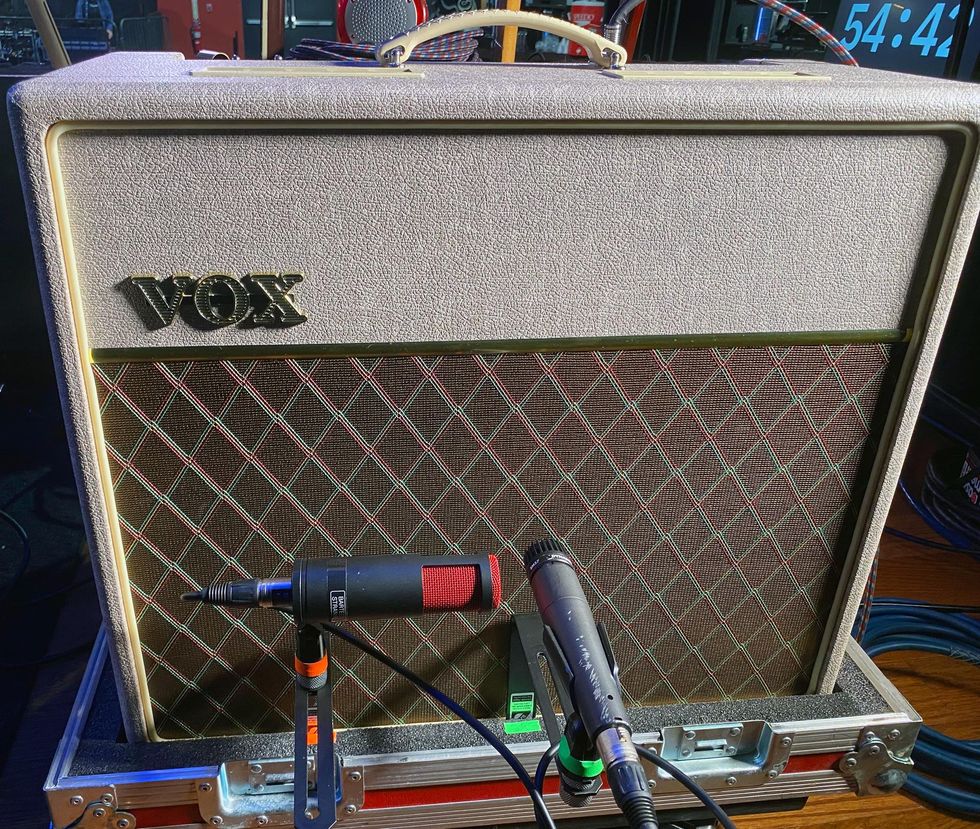
Kleederman puts all three of his electrics through a hand-wired Vox AC15HW1X that comes with a single 12" Celestion Alnico Blue Speaker. He borrowed the combo from Bartees’ FOH, Kitzy. He uses the low input of the top-boost circuit and says it works well for cutting through and providing some defined power to his sound.
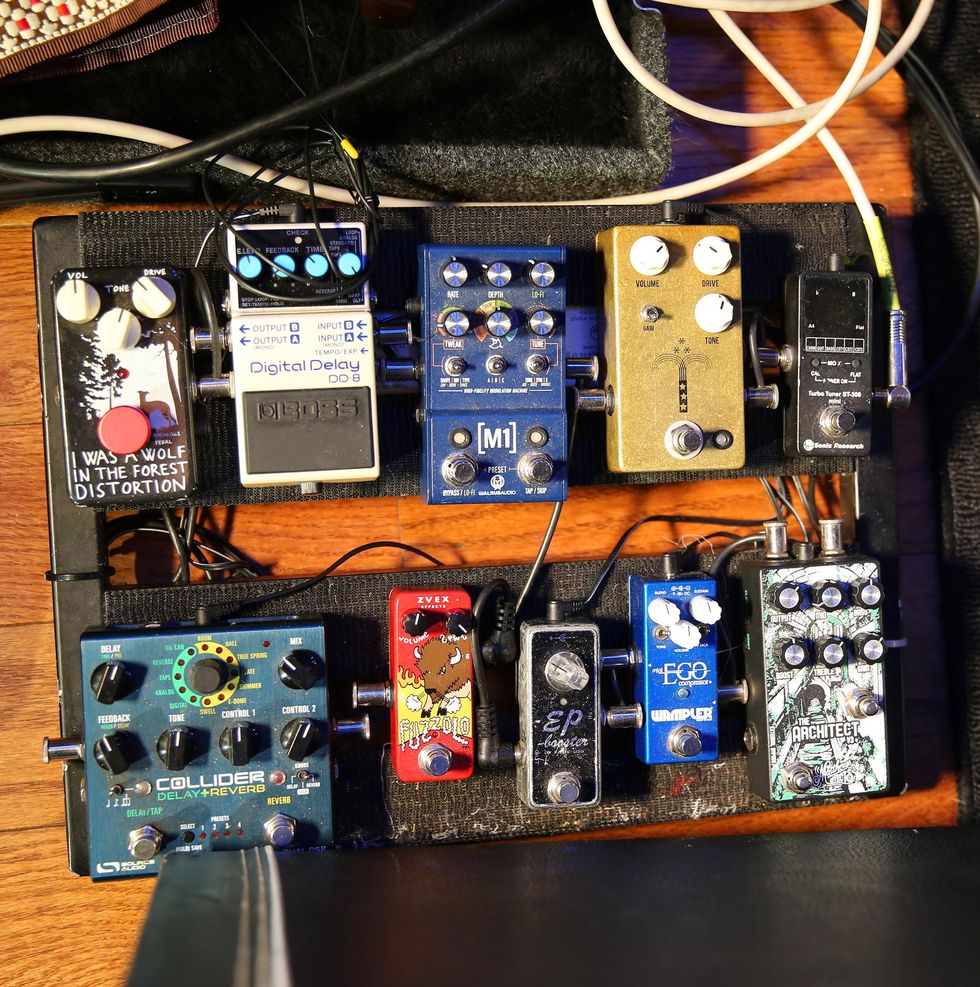
His board starts with an always-on JHS Morning Glory. The next level of grime is the Matthews Effects Architect. He chose this one because it includes a boost, three different clipping modes, and a 3-band EQ, all in a small footprint. A Wampler Mini Ego handles compression, while an Xotic EP Booster gives him another intensifier of volume and gain. The ZVEX Fuzzolo helps Dan double bassist John Daise’s parts in a song like “In a Cab,” or give him a super-gated attack during “Boomer.” Then we enter the section of Dan’s crazier colors that get painted on with a Walrus Audio Mako M1, a Source Audio Collider delay/reverb, and a Boss DD-8 Digital Delay. And, stealing a page out of Bartees’ playbook, Dan slots a distortion (Animals Pedal I Was a Wolf in the Forest Distortion) at the end of his chain to “make everything messy and fun.” Off to the side of his board sits a Dunlop DVP4 Volume Mini Pedal, and a Sonic Research ST-300 Mini Stomp Box Strobe Tuner keeps his instruments steady.




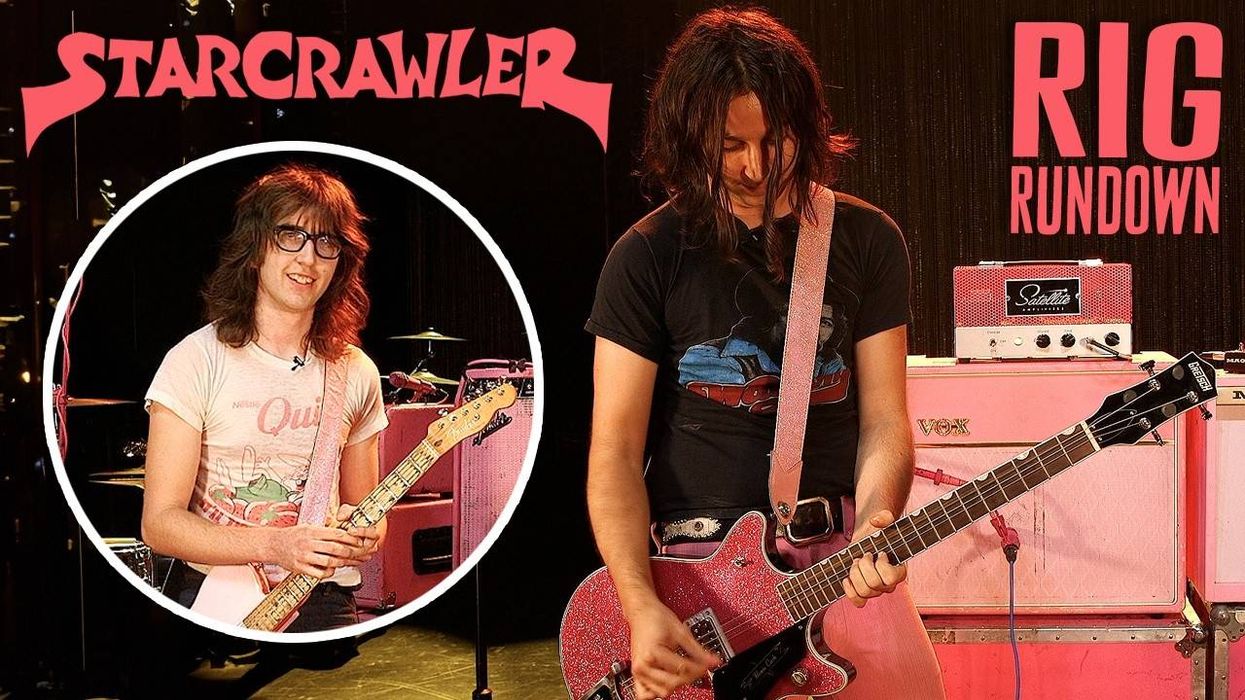
![Devon Eisenbarger [Katy Perry] Rig Rundown](https://www.premierguitar.com/media-library/youtube.jpg?id=61774583&width=1245&height=700&quality=70&coordinates=0%2C0%2C0%2C0)

































